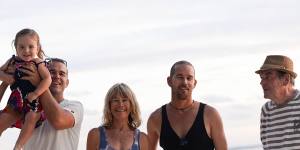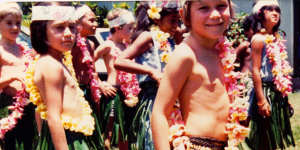And when my best friend came to visit,I forgot to tell him the address he’d be staying at. “I’m staying at my friend’s dad’s house,” he told an immigration officer when they saw he’d left the line blank on his arrival form. He didn’t know my father’s first name,just the surname we share. “Ah,you’re staying with John,” they told him,waving him through. “Just write:John Tansley’s house.”
The Cook Islands is that sort of place:like a South Sea island version of a small-town pub. Rarotonga – where everyone lands – is the biggest of the Cook Islands by far,but you can still drive round it in 40 minutes at 50km/h (40km/h on a scooter). There are 10,000 locals on the island in a good year (Cook Islanders are granted New Zealand passports,giving them easy access out) – and barely 15,000 spread across 15 islands in 2 million square kilometres of ocean. Chinese whispers work better than Vodafone out here.
I was born and raised on Rarotonga. I haven’t lived here full-time for 40 years,but it’s as if I never left. Jetstar might be flying Australians in direct from Sydney three times a week,but Rarotonga’s “capital city” Avarua still has more dogs than cars.

The author (second from right) in 2014 with some members of his family,including his late father,on a Rarotonga beach.Courtesy of Craig Tansley
Rarotonga has those big,green triangular mountains that Tahiti is famous for. I always wondered what was up there – kids at school told me about football-field-sizedmaraes (sacred places serving religious purposes) deep in the hinterland,where human skulls were stacked on tree branches. Tourists come to Rarotonga for the lagoons,but they all end up staring at the mountains,like I do. I swear I’ve seen pterodactyls circling up there with the white angel terns.
There’s one road (Ara Tapu) that goes right round the island,just beside the lagoon – that’s where most people live,and where the hotels and resorts are. But all you need do is drive a few hundred metres inland onto one of the Pacific’s oldest roads (Ara Metua) and it’s another world entirely. Locals feed their pigs and tend to arrowroot,pawpaw and taro plantations beside the roadway. There are dirt roads beyond that wind their way through wilderness to the base of those big green mountains. There are 24 named mountains to climb,if you’re game.
I learnt to swim in the lagoon at the back of my house,dog-paddling between coral heads,crying when the salt got in my eyes. No one ever bothered building a public pool. Our house was so close to the water that during every big storm we’d have to save Dee Dee,the family duck,from his enclosure on the sand beneath the coconut trees. Anywhere you sleep in the Cook Islands,you hear waves crashing on the reef that insulates the lagoon. When they’re big,I can feel the explosion they make in my chest. The sound of it makes me feel safe and anxious at the same time:just like when I was five.

The author learnt to dance in the traditional way while in primary school.Lani Jensen
I learnt to ride scooters in the Cook Islands when I was 15 – and they’re still my preferred mode of transport. Travelling by car is to disregard the in-between bits. Like the smell of backyard burn-offs,or the first glimpse of lagoon through coconut trees,or the piglets playing by the side of the road,or the burst of frangipani and tiare maori (a sweet-smelling gardenia that is the national flower of the Cook Islands) so thick and sweet you can taste it at the back of your throat – especially on warm evenings,when it almost shimmers in the air.
Most locals travel by scooter. I used to be distracted by the sight of their tiny children clinging to their backs as they rode;now I just think they’re born knowing how to hang on. My favourite time to people-watch is Sunday mornings,when everyone’s dolled up on their way to church. For decades,locals didn’t have to wear helmets – they messed up their hair for the service.
My uncle was the Cook Islands’ health minister,then prime minister. He tried for 30 years but even he couldn’t change the law. (It finally changed in 2020.)
I’m related to almost everyone in the Cook Islands through my uncle,not that you have to be family to be “family” in the Cooks. Some local families give up their babies to siblings or friends who can’t have children – I never could work out which of my friends’ parents were their biological parents. It’s these people who make the Cook Islands what they are. If any country’s population was made for tourism,it’s Cook Islanders;they’re the extroverts of the South Pacific. They love conversation as much as they love their food – and Cook Islanders really love their food.
After 55 years in the Cooks,working in legal matters,my father passed away at his home beside Muri Lagoon. My uncle had died,too,shortly before. We lost some of our stake in these islands,but none of the feeling that we belong. My brother moved his family there to give his kids a similar sort of childhood to the one we had. “Nothing’s changed,” he texted me. “It’s still the best place to be a kid.”
To read more from Good Weekendmagazine,visit our page at, and.
